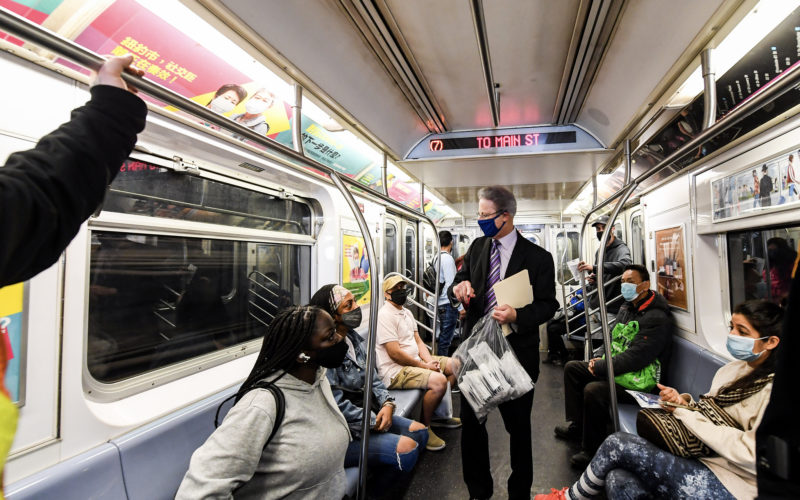

image: SHoP Architects
The Domino Sugar Refinery Redevelopment in South Williamsburg, developed by the Two Trees Management Company and designed by SHoP Architects, is an ambitious 11-acre plan of parks and towers with, among others things, not one, but two massive buildings with holes in them! Two Trees was the main force behind the property boom in DUMBO in the 80s and 90s, and now is trying to work its magic on the abandoned sugar factory site that sits just north of the Williamsburg Bridge on the East River.
The Havemeyer family acquired this land in 1856 and constructed the original refinery in that same year, receiving sugar cane from around the world. By 1870, the factory was refining more than half of all the sugar consumed in the United States. The site saw two devastating fires in 1882 and 1917, but the business rebounded each time with larger facilities. In 2000, the refinery saw the longest labor strike in New York State history, when nearly 300 refinery employees stopped working for 20 months protesting wages and working conditions. As with the majority of industrial activity in New York City, the plant ceased operations in 2004. According to SHoP, the new plan “provides for a 24/7 mix of creative office space, market-rate and affordable housing, neighborhood retail, and community facilities; and is an innovative form of open architecture that connects the existing neighborhood to the new quarter-mile waterfront.”
Recent upzoning along the Queens and Brooklyn waterfront has allowed tall towers to bloom along the East River, and the Domino site is a continuation of this trend. Critics point to the lack of affordable housing in these new developments and therefore Mayor De Blasio has renegotiated the deal with Two Trees to include 30% of the 2,300 units to be affordable, in exchange for more density.
For me, some of this plan is problematic when considered against the overall context. For example, what does “affordable” mean? As I understand it, these affordable units will simply be below market rate, but offer no specificity as to the actual price and its relationship to the surrounding neighborhood market and the city overall. Mayor De Blasio has also required the inclusion of more 2 and 3 bedroom units within this “affordable” group, although the developer would most likely want to keep those larger spaces at market rate to make a profit. Also, the added density bonus will allow for 55 story towers, which will play off of the height of the Williamsburg Bridge but will also loom over the relatively low scale neighborhood adjacent to the new development.
In addition, and what is of most interest to TransitCenter, is the lack of consideration of the transportation angle for this project. The site sits about a 15-minute walk to the Bedford L stop and also a slightly longer walk to the Marcy Ave J/M stop. Already, many bemoan that the L train is at capacity by the time it reaches the Bedford stop during the morning rush, forcing commuters to allow three or four trains to pass before boarding one to Manhattan. I am not as familiar with the woes of the Marcy Ave stop, but adding 2,300 units of housing to this already stressed node in the transportation system does not seem wise. The Domino site also is directly in between two East River Ferry stops, which provide waterfront dwellers with an innovative transit option, but with the high cost of $4 per ride and limited service and stops.
I know that New York has always had a love affair with real estate development, but this plan is problematic and needs a little more tweaking (perhaps scaling down and thinking about transportation) before moving forward. The last thing we need is a 21st Century version of the modernist Tower in the Park failed idea.
 On the Brink: Will WMATA’s Progress Be Erased by 2024?
On the Brink: Will WMATA’s Progress Be Erased by 2024?
The experience of being a WMATA rider has substantially improved over the last 18 months, thanks to changes the agency has made like adding off-peak service and simplifying fares. Things are about to get even better with the launch of all-door boarding later this fall, overnight bus service on some lines starting in December, and an ambitious plan to redesign the Metrobus network. But all of this could go away by July 1, 2024.
Read More What’s Going on With Transit Service at the Seven Highest Ridership U.S. Cities? NYC Edition
What’s Going on With Transit Service at the Seven Highest Ridership U.S. Cities? NYC Edition
New York City Transit’s service levels have remained remarkably strong throughout the pandemic. Crew operator availability remains the agency’s biggest challenge, as well as adjusting weekend maintenance schedules in order to run service that matches strong weekend demand.
Read More